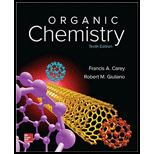
ORGANIC CHEMISTRY (LL)-W/SOLN.>CUSTOM<
10th Edition
ISBN: 9781259972348
Author: Carey
Publisher: MCG CUSTOM
expand_more
expand_more
format_list_bulleted
Question
Chapter 19, Problem 26P
Interpretation Introduction
Interpretation:
The final product with a molecular formula
Concept introduction:
Thionyl chloride
Lithium aluminum hydride is a strong reducing agent. The reduction of a
Oxidation reaction involves an increase in the
Reduction reaction involves a decrease in the
Expert Solution & Answer
Want to see the full answer?
Check out a sample textbook solution
Students have asked these similar questions
When A is reacted with hot aqueous NaOH, a compound B of molecular formula C8H11NO is produced. With this information, write the correct structure of B and propose the reaction mechanism (step by step, with the correct use of arrows) to obtain B.
The compound shown was subjected to the following series of reactions to give a product having the molecular formula C9H9ClO3. What is this product?
An alkene is treated with OsO4 followed by H2O2. When the resulting diol is treated with HIO4, the only product obtained is an unsubstituted cyclic ketone with molecular formula C6H10O. What is the structure of the alkene?
Chapter 19 Solutions
ORGANIC CHEMISTRY (LL)-W/SOLN.>CUSTOM<
Ch. 19.1 - Prob. 1PCh. 19.4 - Prob. 2PCh. 19.5 - Prob. 3PCh. 19.6 - Problem 19.6 What is the most acidic neutral...Ch. 19.7 - Problem 19.6 Write an ionic equation for the...Ch. 19.9 - Prob. 6PCh. 19.11 - Prob. 7PCh. 19.12 - Prob. 8PCh. 19.14 - Prob. 9PCh. 19.15 - Prob. 10P
Ch. 19.16 - Prob. 11PCh. 19.16 - Prob. 12PCh. 19 - Prob. 13PCh. 19 - Prob. 14PCh. 19 - Prob. 15PCh. 19 - Prob. 16PCh. 19 - Show how butanoic acid may be converted to each of...Ch. 19 - Show by a series of equations how could synthesize...Ch. 19 - Prob. 19PCh. 19 - Prob. 20PCh. 19 - Prob. 21PCh. 19 - Give the product of the reaction of pentanoic acid...Ch. 19 - Prob. 23PCh. 19 - Prob. 24PCh. 19 - Each of the follwing reactions has been reported...Ch. 19 - Prob. 26PCh. 19 - Prob. 27PCh. 19 - Prob. 28PCh. 19 - Prob. 29PCh. 19 - Prob. 30PCh. 19 - The 1H NMR spectra of formic acid (HCO2H), maleic...Ch. 19 - Prob. 32PCh. 19 - Prob. 33PCh. 19 - Prob. 34DSPCh. 19 - Prob. 35DSPCh. 19 - Lactonization Methods In Section we saw that...Ch. 19 - Prob. 37DSP
Knowledge Booster
Similar questions
- Nonconjugated , -unsaturated ketones, such as 3-cyclohexenone, are in an acid-catalyzed equilibrium with their conjugated , -unsaturated isomers. Propose a mechanism for this isomerization.arrow_forwardAldehydes and ketones react with thiols to yield thioacetals just as they react with alcohols to yield acetals. Predict the product of the following reaction, and propose a mechanism:arrow_forwardThe treatment of (CH3)2C=CHCH2Br with H2O forms B (molecular formula C5H10O) as one of the products. Determine the structure of B from its 1H NMR and IR spectra.arrow_forward
- When the following compound undergoes solvolysis in ethanol, three products are obtained. Propose a mechanism to account for the formation of these products.arrow_forwardCompound X (molecular formula C10H12O) was treated with NH2NH2,−OH to yield compound Y (molecular formula C10H14). Based on the 1H NMR spectra of X and Y given below, what are the structures of X and Y?arrow_forwardPlease provide the reagents for the following transformations.arrow_forward
- Predict the products for each of the following reactions and propose a mechanism that explains the formation of each product.arrow_forwardProvide reaction mechanisms for the following transformationsarrow_forwardThe following reaction was performed as part of a research program sponsored by the National Institutes of Health to develop therapeutic agents for the treatment of cocaine addiction. Using what you have seen about the reactions of halogens with alkenes, propose a mechanism for this process.arrow_forward
- The following are intermediate products in the stepwise synthesis of compound 1 from benzene. Give the correct sequence of reactions with the appropriate reagents that will lead to the correct intermediate products and final product. Br Br Br 1 2 4 3 5arrow_forwardProvide a step-by-step mechanism to account for the product of the following reaction. Show the structure of each of the intermediates and use curved arrows to indicate electron flow in each of these stepsarrow_forwardCompound A reacts with the reagents shown in the image. Write the mechanism, step by step, for the formation of product B. Note that B has the molecular formula C14 H18 O.arrow_forward
arrow_back_ios
SEE MORE QUESTIONS
arrow_forward_ios
Recommended textbooks for you
